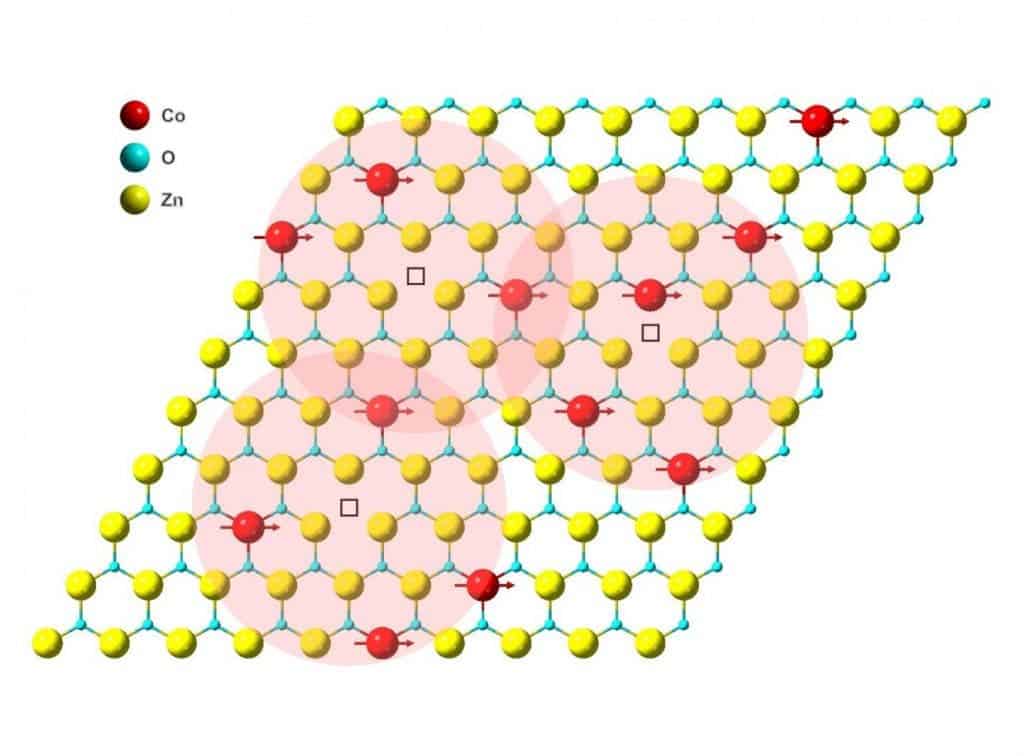
In a world first, researchers at the Lawrence Berkeley National Laboratory and the University of California Berkeley have created an atom-thick magnet that can operate at room temperature. The ultrathin magnet could lead to a new class of storage devices that could store orders of magnitude more data per volume than the current, state of the art devices. Such two-dimensional (2D) magnets may also prove useful in probing the mysterious world of quantum physics.
“We’re the first to make a room-temperature 2D magnet that is chemically stable under ambient conditions,” said senior author Jie Yao, a faculty scientist in Berkeley Lab’s Materials Sciences Division and associate professor of materials science and engineering at UC Berkeley.
“This discovery is exciting because it not only makes 2D magnetism possible at room temperature, but it also uncovers a new mechanism to realize 2D magnetic materials,” added Rui Chen, a UC Berkeley graduate student in the Yao Research Group and lead author on the study.
A one-atom thin 2D magnet that works at room temperature
Modern storage devices that store data by relying on a magnetized medium typically contain very thin magnetic films. These films may be only thousands or even hundreds of atoms thick, which is impressive in and of itself, but scientists always want to push the boundaries.
For decades, physicists have been trying to make 2D magnets that are no thicker than an atom. Doing so would allow them to cram in more data per square inch.
Some of these efforts have paid off with promising results, but their major drawback was that these previously devised 2D magnets became unstable at room temperature.
“State-of-the-art 2D magnets need very low temperatures to function. But for practical reasons, a data center needs to run at room temperature,” Yao said. “Theoretically, we know that the smaller the magnet, the larger the disc’s potential data density. Our 2D magnet is not only the first that operates at room temperature or higher, but it is also the first magnet to reach the true 2D limit: It’s as thin as a single atom!”
Yao and colleagues synthesized a new material called a cobalt-doped van der Waals zinc-oxide magnet. Although the name might be a mouthful, it perfectly describes what this magnet is all about: a single atomic layer of zinc-oxide with a tiny pinch of cobalt. During the synthesis process, the material is sandwiched between layers of graphene, which are later removed, leaving behind just a single atomic layer of cobalt-doped zinc-oxide. It’s an accessible and scalable manufacturing process for mass production at a low cost.
The 2D magnet went through a battery of tests, including scanning electron microscopy experiments that revealed the material’s morphology and transmission electron microscopy imaging to probe the material atom by atom. These investigations proved that the magnet really is no more than an atom thick.
Next, they showed that it remains stable at room temperature. Using powerful X-ray sources at Berkeley Lab’s Advanced Light Source and SLAC National Accelerator Laboratory’s Stanford Synchrotron Radiation Lightsource, the researchers described the electronic and crystal structures of the 2D magnet for different concentrations of cobalt.
According to the results, the graphene-zinc-oxide material becomes magnetic at 5-6% concentration of cobalt, while increasing the concentration to 12% results in a very powerful magnet.
Experiments not only showed that the material retains its magnetism at room temperature but can also withstand temperatures as high as 100 degrees Celsius (212 degrees Fahrenheit). The new material can also bend into almost any shape without breaking.
“Our 2D magnetic system shows a distinct mechanism compared to previous 2D magnets,” said Chen. “And we think this unique mechanism is due to the free electrons in zinc oxide.”
Possible applications in computing and electronics
Data is written on magnetic memory, such as a magnetic hard drive, by flipping the direction of the two poles (north and south) of microscopic magnets using an external magnetic field. Free electrons in the 2D magnet always follow the direction of electric currents and ensure the magnetic cobalt atoms in the material continue pointing in the same direction, thus staying magnetic.
This property could open the door for applications in spin electronics, also known as spintronics, whereby data can be encoded in an electron’s spin rather than its charge.
“I believe that the discovery of this new, robust, truly two-dimensional magnet at room temperature is a genuine breakthrough by Jie Yao and his students,” said co-author Robert Birgeneau, a faculty senior scientist in Berkeley Lab’s Materials Sciences Division and professor of physics at UC Berkeley who co-led the study’s magnetic measurements. “In addition to its obvious significance to spintronic devices, this 2D magnet is fascinating at the atomic level, revealing for the first time how cobalt magnetic atoms interact over ‘long’ distances through a complex two-dimensional network,” he added.”Our results are even better than what we expected, which is really exciting. Most of the time in science, experiments can be very challenging,” he said. “But when you finally realize something new, it’s always very fulfilling.”
The findings appeared in the journal Nature Communications.









